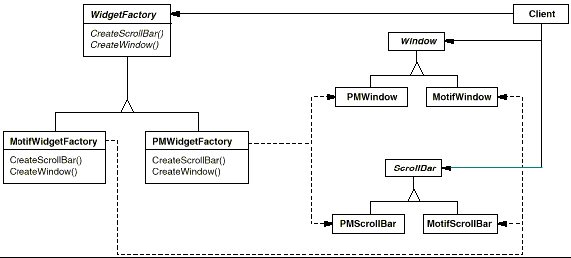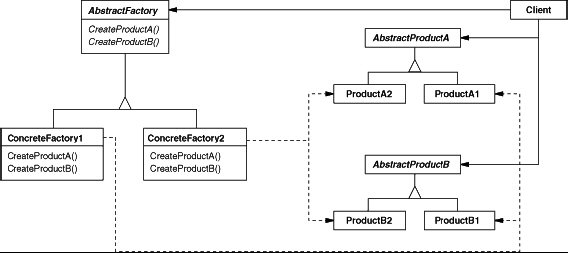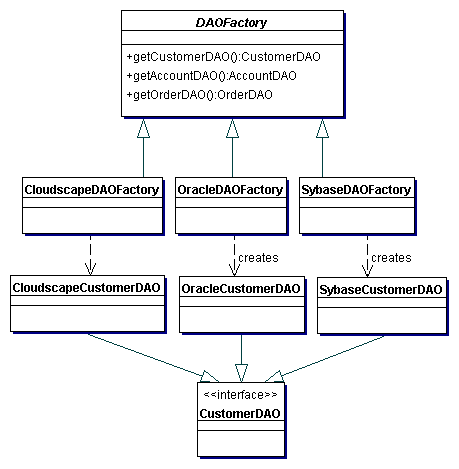Abstract Factory
Intent
Provide an interface for creating families of related or dependent objects without specifying their concrete classes.
Also Known As
Kit
Motivation
Consider a user interface toolkit that supports multiple look-and-feel standards, such as Motif and Presentation Manager. Different look-and-feels define different appearances and behaviors for user interface "widgets" like scroll bars, windows, and buttons. To be portable across look-and-feel standards, an application should not hard-code its widgets for a particular look and feel. Instantiating look-and-feel-specific classes of widgets throughout the application makes it hard to change the look and feel later.
We can solve this problem by defining an abstract WidgetFactory class that declares an interface for creating each basic kind of widget. There's also an abstract class for each kind of widget, and concrete subclasses implement widgets for specific look-and-feel standards. WidgetFactory's interface has an operation that returns a new widget object for each abstract widget class. Clients call these operations to obtain widget instances, but clients aren't aware of the concrete classes they're using. Thus clients stay independent of the prevailing look and feel.

|
| Figure 1 Abstract Factory Example |
There is a concrete subclass of WidgetFactory for each look-and-feel standard. Each subclass implements the operations to create the appropriate widget for the look and feel. For example, the CreateScrollBar operation on the MotifWidgetFactory instantiates and returns a Motif scroll bar, while the corresponding operation on the PMWidgetFactory returns a scroll bar for Presentation Manager. Clients create widgets solely through the WidgetFactory interface and have no knowledge of the classes that implement widgets for a particular look and feel. In other words, clients only have to commit to an interface defined by an abstract class, not a particular concrete class.
A WidgetFactory also enforces dependencies between the concrete widget classes. A Motif scroll bar should be used with a Motif button and a Motif text editor, and that constraint is enforced automatically as a consequence of using a MotifWidgetFactory.
Applicability
Use the Abstract Factory pattern when:
- a system should be independent of how its products are created, composed, and represented.
- a system should be configured with one of multiple families of products.
- a family of related product objects is designed to be used together, and you need to enforce this constraint.
- you want to provide a class library of products, and you want to reveal just their interfaces, not their implementations.
Structure

|
| Figure 2 Abstract Factory Structure |
Participants
- AbstractFactory (WidgetFactory)
- declares an interface for operations that create abstract product objects.
- ConcreteFactory (MotifWidgetFactory, PMWidgetFactory)
- implements the operations to create concrete product objects.
- AbstractProduct (Window, ScrollBar)
- declares an interface for a type of product object.
- ConcreteProduct (MotifWindow, MotifScrollBar)
- defines a product object to be created by the corresponding concrete factory.
- implements the AbstractProduct interface.
- Client
- uses only interfaces declared by AbstractFactory and AbstractProduct classes.
Collaborations
- Normally a single instance of a ConcreteFactory class is created at run-time. This concrete factory creates product objects having a particular implementation. To create different product objects, clients should use a different concrete factory.
- AbstractFactory defers creation of product objects to its ConcreteFactory subclass.
Consequences
The Abstract Factory pattern has the following benefits and liabilities:
- It isolates concrete classes. The Abstract Factory pattern helps you control the classes of objects that an application creates. Because a factory encapsulates the responsibility and the process of creating product objects, it isolates clients from implementation classes. Clients manipulate instances through their abstract interfaces. Product class names are isolated in the implementation of the concrete factory; they do not appear in client code.
- It makes exchanging product families easy. The class of a concrete factory appears only once in an application—that is, where it's instantiated. This makes it easy to change the concrete factory an application uses. It can use different product configurations imply by changing the concrete factory. Because an abstract factory creates a complete family of products, the whole product family changes at once. In our user interface example, we can switch from Motif widgets to Presentation Manager widgets simply by switching the corresponding factory objects and recreating the interface.
- It promotes consistency among products. When product objects in a family are designed to work together, it's important that an application use objects from only one family at a time. AbstractFactory makes this easy to enforce.
- Supporting new kinds of products is difficult. Extending abstract factories to produce new kinds of Products isn't easy. That's because the AbstractFactory interface fixes the set of products that can be created. Supporting new kinds of products requires extending the factory interface, which involves changing the AbstractFactory class and all of its subclasses. We discuss one solution to this problem in the Implementation section.
Implementation
Here are some useful techniques for implementing the Abstract Factory pattern.
- Factories as singletons. An application typically needs only one instance of a ConcreteFactory per product family. So it's usually best implemented as a Singleton.
- Creating the products.
- AbstractFactory only declares an interface for creating products. It's up to ConcreteProduct subclasses to actually create them. The most common way to do this is to define a factory method (see Factory Method) for each product. A concrete factory will specify its products by overriding the factory method for each. While this implementation is simple, it requires a new concrete factory subclass for each product family, even if the product families differ only slightly.
- If many product families are possible, the concrete factory can be implemented using the Prototype pattern. The concrete factory is initialized with a prototypical instance of each product in the family, and it creates a new product by cloning its prototype. The Prototype-based approach eliminates the need for a new concrete factory class for each new product family.
- Defining extensible factories.
- AbstractFactory usually defines a different operation for each kind of product it can produce. The kinds of products are encoded in the operation signatures. Adding a new kind of product requires changing the AbstractFactory interface and all the classes that depend on it.
- A more flexible but less safe design is to add a parameter to operations that create objects. This parameter specifies the kind of object to be created. It could be a class identifier, an integer, a string, or anything else that identifies the kind of product. In fact with this approach, AbstractFactory only needs a single "Make" operation with a parameter indicating the kind of object to create. This is the technique used in the Prototype- and the class-based abstract factories discussed earlier.
Sample Code
Consider an example where we are considering implementing this strategy for three different databases. In this case, the Abstract Factory pattern can be employed. The class diagram for this example is shown in Figure 9.8. The sample code in Example 9.1 shows code excerpt for the abstract DAOFactory class. This factory produces DAOs such as CustomerDAO, AccountDAO, OrderDAO, and so forth. This strategy uses the Factory Method implementation in the factories produced by the Abstract Factory.

|
| Figure 3 Abstract Factory DAO Example |
Abstract DAO Factory
Listing 1 Abstract DAO Factory
==============================
// Abstract class DAO Factory
public abstract class DAOFactory {
// List of DAO types supported by the factory
public static final int CLOUDSCAPE = 1;
public static final int ORACLE = 2;
public static final int SYBASE = 3;
...
// There will be a method for each DAO that can be
// created. The concrete factories will have to
// implement these methods.
public abstract CustomerDAO getCustomerDAO();
public abstract AccountDAO getAccountDAO();
public abstract OrderDAO getOrderDAO();
...
public static DAOFactory getDAOFactory(
int whichFactory) {
switch (whichFactory) {
case CLOUDSCAPE:
return new CloudscapeDAOFactory();
case ORACLE :
return new OracleDAOFactory();
case SYBASE :
return new SybaseDAOFactory();
...
default :
return null;
}
}
}
Concrete DAOFactory Implementation for Cloudscape
The sample code for CloudscapeDAOFactory is shown in Listing 2. The implementation for OracleDAOFactory and SybaseDAOFactory are similar except for specifics of each implementation, such as JDBC driver, database URL, and differences in SQL syntax, if any.
Listing 2 Concrete DAOFactory Implementation for Cloudscape
===========================================================
// Cloudscape concrete DAO Factory implementation
import java.sql.*;
public class CloudscapeDAOFactory extends DAOFactory {
public static final String DRIVER=
"COM.cloudscape.core.RmiJdbcDriver";
public static final String DBURL=
"jdbc:cloudscape:rmi://localhost:1099/CoreJ2EEDB";
// method to create Cloudscape connections
public static Connection createConnection() {
// Use DRIVER and DBURL to create a connection
// Recommend connection pool implementation/usage
}
public CustomerDAO getCustomerDAO() {
// CloudscapeCustomerDAO implements CustomerDAO
return new CloudscapeCustomerDAO();
}
public AccountDAO getAccountDAO() {
// CloudscapeAccountDAO implements AccountDAO
return new CloudscapeAccountDAO();
}
public OrderDAO getOrderDAO() {
// CloudscapeOrderDAO implements OrderDAO
return new CloudscapeOrderDAO();
}
...
}
Base DAO Interface for Customer
The CustomerDAO interface shown in Listing 3 defines the DAO methods for Customer persistent object that are implemented by all concrete DAO implementations, such as CloudscapeCustomerDAO, OracleCustomerDAO, and SybaseCustomerDAO. Similar, but not listed here, are AccountDAO and OrderDAO interfaces that define the DAO methods for Account and Order business objects respectively.
Listing 3 Base DAO Interface for Customer
=========================================
// Interface that all CustomerDAOs must support
public interface CustomerDAO {
public int insertCustomer(...);
public boolean deleteCustomer(...);
public Customer findCustomer(...);
public boolean updateCustomer(...);
public RowSet selectCustomersRS(...);
public Collection selectCustomersTO(...);
...
}
Cloudscape DAO Implementation for Customer
The CloudscapeCustomerDAO implements the CustomerDAO as shown in Listing 4. The implementation of other DAOs, such as CloudscapeAccountDAO, CloudscapeOrderDAO, OracleCustomerDAO, OracleAccountDAO, and so forth, are similar.
Listing 4 Cloudscape DAO Implementation for Customer
====================================================
/ CloudscapeCustomerDAO implementation of the
// CustomerDAO interface. This class can contain all
// Cloudscape specific code and SQL statements.
// The client is thus shielded from knowing
// these implementation details.
import java.sql.*;
public class CloudscapeCustomerDAO implements
CustomerDAO {
public CloudscapeCustomerDAO() {
// initialization
}
// The following methods can use
// CloudscapeDAOFactory.createConnection()
// to get a connection as required
public int insertCustomer(...) {
// Implement insert customer here.
// Return newly created customer number
// or a -1 on error
}
public boolean deleteCustomer(...) {
// Implement delete customer here
// Return true on success, false on failure
}
public Customer findCustomer(...) {
// Implement find a customer here using supplied
// argument values as search criteria
// Return a Transfer Object if found,
// return null on error or if not found
}
public boolean updateCustomer(...) {
// implement update record here using data
// from the customerData Transfer Object
// Return true on success, false on failure or
// error
}
public RowSet selectCustomersRS(...) {
// implement search customers here using the
// supplied criteria.
// Return a RowSet.
}
public Collection selectCustomersTO(...) {
// implement search customers here using the
// supplied criteria.
// Alternatively, implement to return a Collection
// of Transfer Objects.
}
...
}
Customer Transfer Object
The Customer Transfer Object class is shown in Listing 5. This is used by the DAOs to send and receive data from the clients. The usage of Transfer Objects is discussed in detail in the Transfer Object pattern.
Listing 5 Customer Transfer Object
==================================
public class Customer implements java.io.Serializable {
// member variables
int CustomerNumber;
String name;
String streetAddress;
String city;
...
// getter and setter methods...
...
}
Using a DAO and DAO Factory - Client Code
Listing 6 Using a DAO and DAO Factory - Client Code
===================================================
...
// create the required DAO Factory
DAOFactory cloudscapeFactory =
DAOFactory.getDAOFactory(DAOFactory.DAOCLOUDSCAPE);
// Create a DAO
CustomerDAO custDAO =
cloudscapeFactory.getCustomerDAO();
// create a new customer
int newCustNo = custDAO.insertCustomer(...);
// Find a customer object. Get the Transfer Object.
Customer cust = custDAO.findCustomer(...);
// modify the values in the Transfer Object.
cust.setAddress(...);
cust.setEmail(...);
// update the customer object using the DAO
custDAO.updateCustomer(cust);
// delete a customer object
custDAO.deleteCustomer(...);
// select all customers in the same city
Customer criteria=new Customer();
criteria.setCity("New York");
Collection customersList =
custDAO.selectCustomersTO(criteria);
// returns customersList - collection of Customer
// Transfer Objects. iterate through this collection to
// get values.
...
Complete Language examples
- Github hjmf1954, Java-Abstract-Factory-Pattern. A complete working demo in Java and ANT.
- Github hjmf1954, PHP-Abstract-Factory-Pattern. A complete working demo in PHP no other tools needed. Also an example of the Singleton pattern.
Related Patterns
Abstract Factory classes are often implemented with factory methods, but they can also be implemented using Prototype. A concrete factory is often a singleton.
See also
- wikipedia:Abstract_factory_pattern
- dzone, Design Patterns Abstract Factory.